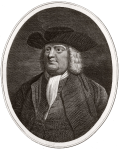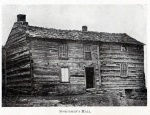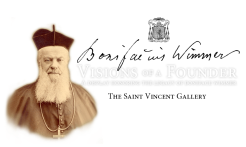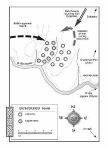by Jay Steel Hackenbracht
This is a story about early American Exceptionalism. Oppressed people Came to America because they had a dream that there was a better opportunity for them to excel and contribute to society. This belief was fueled by the various religious beliefs and passions that they held.
William Penn was born into a distinguished Anglican family– he was the son of Admiral Sir William Penn. He became convinced (one does not convert to Quakerism) that he should join the Society of Friends (Quakers) at the age of 22, and was promptly ostracized by British society, and for a time, thrown in jail (the Tower of London) because of these beliefs.
William Penn wanted the Pennsylvania colony, founded in 1681, to stand for religious tolerance, and as a result, the Pennsylvania Experiment was soon flooded with Europe’s outcasts. Mennonite, Amish, Catholic, and Jewish immigrants flocked to Penn’s colony. Huguenots, Lutherans, Muslims, and a wide variety of other persecuted people came. They were joined by Secularists and those who, with religious fervor, emphatically claimed no religion at all. At that time, such tolerance was not as prevalent in the surrounding colonies. This Exceptionalism was forged by events like the ones in this story–
A grandson of James Steel, the immigrant ancestor of 1772, was John Steel, who married Susan Geiger, whose grandfather had also served in the Revolution. In 1800, her father paid cash for a 275-acre farm close to Latrobe, PA, in Unity Township, close to many other Steel farms. John and Susanna raised twelve children on that farm, about a day’s ride from Pittsburgh. They also had an Inn, since the farm was on present-day Interstate 30 (aka Pennsylvania Turnpike, at that time), then the major road from Philadelphia to points west. Part of this land is now the site of St. Vincent College on the east, and St. Xavier’s Academy on the west. It required people with backgrounds that were Catholic and Protestant, and Irish and German, to work together to help both sides be successful.
Ten years prior to the Geiger purchase, Father Theodore Browers, a Minorite Franciscan, and native of Holland, had laid claim to a purchase of 313 acres of much of the same land, called “Sportsman’s Hall” deeded to John Fraser of Bedford, England, in 1766, shortly after the French and Indian War. It took them nine whole years to resolve the conflicting titles, but a solution was peaceably reached.(1) The Fraser purchase pre-dated the Geiger purchase, and land also came from Henry Kuhn, George Ruffner, John Proctor, and others for these schools and institutions.
With the aid of Henry Kuhn and other advisers in the community, they soon realized that the “Sportsman’s Hall” location on the highway was better for the community, and for the parish, than the 154 acre “O’Neill’s Victory”(2) location on the eastern bank of the Loyalhanna River (now part of Keystone State Park), that Father Browers had purchased when he had been back East in Chester County. The location is some 12 miles to the north of Latrobe. By having high esteem for themselves, and for the others involved, they came together and discovered How to Resolve Misunderstanding.
This was at the time of the Irish Potato Famine. The same crop failure affected most all of Europe during the 1840’s. Millions of Irish and German immigrants came to the New World. But this was just the beginning– from 1880-1920, over 20 million immigrants entered the United States, due to industrialization, urbanization, religious persecution and threats of war.
Because they forged a solution, both the Sisters of Mercy (who came from Ireland in 1843) and the Benedictines (who came from Germany in 1846) were established in America. The parish built Saint Vincent Basilica, St. Xavier’s Academy, St. Vincent College, St. Vincent Seminary and St. Vincent Archabbey on this land.
In the 1840’s, could anyone have dreamed of the positive impact they would have? Today, on Google, I got 2,970,000 hits for “Mercy Hospital.” I have no idea how many Mercy Hospitals the Sisters of Mercy have started, but this would be a leading brand. With about 400 students graduating per year, St. Vincent College has educated about 100,000 students. It is impossible to adequately measure the rich contribution towards American Exceptionalism that these institutions have made in the areas of teaching, hospital work, business and charity. Contrary to their ancestors, and together with their neighbors, they had discovered that a person can be Catholic, Protestant, German, Irish, or a combination of these, and be Exceptional.
In stark contrast, in Philadelphia, they had the Philadelphia Bible War of 1844.(3) Eventually, they gave up their old-world conflicts, and in “brotherly love“ worked towards Exceptional solutions, also.
Imagine– just for a moment— if Catholic, Protestant, German, and Irish people from the Latrobe, Pennsylvania area had not gotten together, and worked out a positive solution for all. Can you see a shopping mall… perhaps some office buildings… or maybe a city park… at this location? Think of the Exceptionalism that would have been missed! These bragging rights, would not belong to Western Pennsylvania, if they existed at all.
One more thing– St. Vincent College is so Exceptional, they host the pre-season training for the Pittsburgh Steelers!
“Man’s adversity is God’s opportunity.”–Archabbot Boniface Wimmer, O.S.B.
__________________
Foot Notes:
1. For those of you that are thinking that this is just a bunch of “flag-waving,” check out Scilla Elworthy’s TED Talk on Fighting with non-violence. And take a look at From Dictatorship to Democracy by Gene Sharp. American Exceptionalism works. Think of it this way– In the 1800’s, over 20 million oppressed souls were dumped into this American melting pot. They were not happy with previous management, and for good reason. There simply had to be a better way than, say, a Thirty Years’ War, let alone a Second Thirty Years’ War. There was too much fighting, and over the most ridiculous misunderstandings. In the New World, transportation and communication made it a whole lot easier for folks to talk things over, in a common language, instead of mustering an army. Don’t get me wrong, there are times to go to war– there have simply been too many opportunities for peace that have been missed. Sometimes, you, me, our ancestors– have all argued over some of the most petty issues. Stories like this one show what made America Exceptional.
2. In 1789, why did Father Browers (who died the next year, Oct 29, 1790) refer to the Loyalhanna River location as “O’Neill’s Victory?” He had bought the property from Arthur O’Neil of Chester County (just west of Philadelphia). In addition, looking at the history of Ulster, Ireland, 143 years earlier, there was the Battle of Benburb. The O’Neill’s were a military force in Ireland, tracing their lineage to the 5th century Eógan mac Néill. The battle was against Scottish Covenanter Robert Munro, and his superior force of 6,000 infantry and 800 cavalry. O’Neill won a major victory, attacking from higher ground with Monro’s forces with their backs to the River Blackwater. This “O’Neill’s Victory,” as it was called, was the only major victory the Irish forces won between 1641 and 1653. Perhaps the good Father therefore saw the location on the Loyalhanna in a similar positive light, and Henry Kuhn, being the real estate wise layman, re-directed him to “Sportsman’s Hall.”
3. Of all the stupid things to fight over! See the post (especially the footnotes) on Penn Jillette. It isn’t the label, it is the content of our character(21) that matters.
Lessons learned:
a) Father Browers did as he was trained. He depended on his knowledge of former events. (They don’t teach Real Estate in Seminary.)
b) It is always helpful to have knowledgeable layman in your parish.
c) Former rivals worked together. On the Scotch and Irish side, 143 years prior, the ancestors of these Latrobe-area immigrants had been mortal enemies. In “Team of Rivals“ fashion, the key differences that helped to produce this case of early American Exceptionalism were:
- land was not scarce, to be fought over,
- they had a common language,
- There was an additional mix of persecuted German ex-patriots, and
- at the time, they had a common enemy– Seneca chief Guyasutha and his warriors burned Hanna’s Town to the ground in 1782.
- They also had no local native “turf” to defend, and they were mixed closer together.
- They were all ex-patriots, escaping hardship for a land that was promised to be bound together by religious tolerance, and a hope for Exceptionalism.
By having high esteem for themselves, and for the other parties, they came together and discovered How to Resolve Misunderstanding. And it worked.
d) Labels didn’t count. It wasn’t the label “Covenanter” or “Benedictine” or “papist” or “nativist” or “Catholic” or “Protestant” or their ex-patriot background that won the day, but having come from oppression, and having decided that it was time for a New World, the difference was in the empirically verifiable content of their character. (22)
© 2012-2013 by Jay Steel Hackenbracht, All Rights Reserved. Republishing requires written consent of the author.
___________________________
Additional Notes and Info:
- Electric Scotland– The History of Ulster– The Battle of Benburb
- wiki on Battle of Benburb
- wiki on O’Neill Dynasty
- wiki on Owen Roe O’Neill
- wiki on Robert Monro
- wiki on River Blackwater, Northern Ireland
- History Reconsidered– O’Neill’s Rebellion
- Chapter XXVI, The Destruction of Hannastown
- Burning of Hannastown
- Hanna’s Town – Westmoreland County Historical Society
- The Burning of Hanna’s Town
- History of the Diocese of Pittsburgh
- Records of the American Catholic Historical Society of Philadelphia, Volume 21 (Google eBook) American Catholic Historical Society of Philadelphia, 1911.
- Records of the American Catholic Historical Society of Philadelphia, Volume 3 (Google eBook) American Catholic Historical Society of Philadelphia, 1891.
- 1646: The Battle of Benburb
- Library Ireland– BENBURB, or BINBURB, a small village
- Irish Surname – O’Néill
- River Blackwater
- Covenanter
- Robert Munro
- I Have a Dream Speech Quote
- Martin Luther King’s I Have A Dream Speech 1:20 min Excerpt










